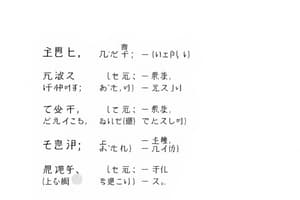Podcast
Questions and Answers
How does adding a suffix typically change a word?
How does adding a suffix typically change a word?
- It only affects the length of the word.
- It only changes the pronunciation of the word.
- It always converts the word into a verb.
- It alters the word's meaning, its part of speech, or both. (correct)
Which of the following transformations demonstrates the use of a suffix to change a verb to a noun?
Which of the following transformations demonstrates the use of a suffix to change a verb to a noun?
- `read` to `reading`
- `quick` to `quickly`
- `hope` to `hoped`
- `create` to `creation` (correct)
Identify the primary function of the suffix -s when added to a noun.
Identify the primary function of the suffix -s when added to a noun.
- To form the possessive case.
- To indicate past tense.
- To denote the comparative form of an adjective.
- To change a singular noun into its plural form. (correct)
In which of the following sentences is the suffix -ed correctly used to indicate the simple past tense?
In which of the following sentences is the suffix -ed correctly used to indicate the simple past tense?
Which suffix, when added to a verb, typically creates a noun that signifies a state or condition?
Which suffix, when added to a verb, typically creates a noun that signifies a state or condition?
Which of the following words does not follow the pattern of verb to noun conversion using the '-tion' suffix as described?
Which of the following words does not follow the pattern of verb to noun conversion using the '-tion' suffix as described?
The word 'system' is a noun. Which of the following sentences demonstrates the correct usage of its '-ic' adjective form?
The word 'system' is a noun. Which of the following sentences demonstrates the correct usage of its '-ic' adjective form?
Consider the adjective 'eager'. Which adverb correctly uses the '-ly' suffix, and in what context is it most appropriate?
Consider the adjective 'eager'. Which adverb correctly uses the '-ly' suffix, and in what context is it most appropriate?
Which of the following best describes the semantic shift that occurs when the '-ous' suffix is added to a noun to form an adjective?
Which of the following best describes the semantic shift that occurs when the '-ous' suffix is added to a noun to form an adjective?
Given the examples provided, which sentence demonstrates the most accurate use of a word formed with the '-ate' suffix?
Given the examples provided, which sentence demonstrates the most accurate use of a word formed with the '-ate' suffix?
Flashcards
What is a Suffix?
What is a Suffix?
A letter or group of letters added to the end of a word to change its meaning or grammatical function.
What do plural nouns indicate?
What do plural nouns indicate?
Nouns that denote multiple persons, places, things or ideas.
Suffixes added to verbs
Suffixes added to verbs
Shows inflections or verb tenses.
What does '-ed' indicate?
What does '-ed' indicate?
Signup and view all the flashcards
-tion suffix meaning
-tion suffix meaning
Signup and view all the flashcards
'-tion' Suffix
'-tion' Suffix
Signup and view all the flashcards
'-ic' Suffix
'-ic' Suffix
Signup and view all the flashcards
'-ly' Suffix
'-ly' Suffix
Signup and view all the flashcards
'-ous' Suffix
'-ous' Suffix
Signup and view all the flashcards
'-ate' Suffix
'-ate' Suffix
Signup and view all the flashcards
Study Notes
- A suffix is a letter or group of letters added after a word, modifying its meaning and/or part of speech.
- Suffixes help readers understand the meanings and grammatical functions of unfamiliar words.
Suffix Examples
- The suffix "-s" is commonly used to pluralize nouns.
- Singular: chair, bottle, boy
- Plural: chairs, bottles, boys
- Suffixes like "-s" and "-ed" indicate verb inflections or tenses.
- "-s" is added to the base form of a verb to inflect the third person singular.
- play (you, they) -> plays (he, she, it)
- "-ed" is added to regular verbs to form the simple past tense.
- walk -> walked, stay -> stayed
- "-s" is added to the base form of a verb to inflect the third person singular.
List of Suffixes
- -s, -tion, -ing, -ion, -ate, -ly
- -less, -or, -ish, -ity, -ful, -en
- -ed, -ic, -ous, -able, -est, -er
"-tion" Suffix Meaning
- "-tion" denotes a state or condition.
- It's added to verbs to form nouns indicating the state of an action:
- frustrate -> frustration, illustrate -> illustration
"-ic" Suffix Meaning
- "-ic" is an adjective-forming suffix.
- It changes a noun to an adjective, often meaning "relating to," "consisting of," or "coming from."
- hero (noun) -> heroic (adjective)
- Examples: aquatic, idiotic, romantic, logic, periodic
"-ly" Suffix Meaning
- "-ly" forms adverbs from adjectives.
- The "-ly" meaning can be "in a manner," "to a degree," or "with respect to."
- annual (adjective) -> annually (adverb)
- Examples: slowly, partly, sufficiently, hastily, understandably
"-ous" Suffix Meaning
- "-ous" makes adjectives, meaning "full of."
- It changes nouns to adjectives, altering their meanings.
- venom (noun) -> venomous (adjective)
- Examples: poisonous, adventurous, courageous, synonymous, monotonous
"-ate" Suffix Meaning
- "-ate" can form nouns, adjectives, or verbs, changing word meanings.
- emir (noun) -> emirate (noun): ruler to a state
- active (adjective) -> activate (verb): alive to mobilize
- affection (noun) -> affectionate (adjective): desire to friendly/caring
Studying That Suits You
Use AI to generate personalized quizzes and flashcards to suit your learning preferences.
Description
Explore suffixes, letters added to the end of words, changing their meaning. Learn how suffixes like '-s,' '-ed,' '-tion,' and '-ic' alter word forms and functions. See examples of suffix usage.




